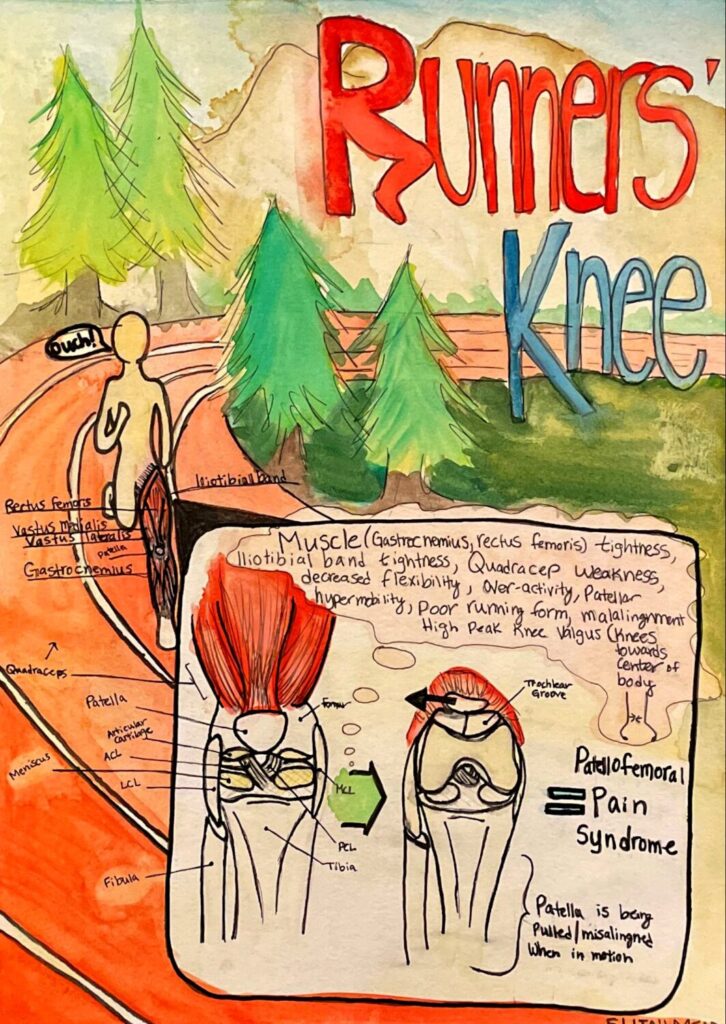Project Description: (NOT Essay)
I chose this condition because it is one that I experienced somewhat recently, and is very common within the sport of running which is something important to me. I wanted to a painting displaying a setting in which the symptoms of this condition can be felt- I also wanted my painting to reflect how this condition affects the anatomy of the knee joint, but is onset by factors related to the entire leg. The zoomed in portion of the Patellofemoral area shows how when the knee flexes people with this condition experience improper tracking of the patella in the trochlear groove.
Runners’ Knee is the common name for the condition Patellofemoral Pain Syndrome(which I will use for the purposes of this essay as it is what’s used in the studies cited). Patellofemoral Pain Syndrome is a common injury amongst runners (Yang, 2022) I myself have actually experienced it. It is estimated that about 19% to 30% of Female Runners, and about 13% to 25% of Male Runners experience this condition, and it is considered to be the most common Musculoskeletal overuse related injury in active adults.(Mellinger, 2017). According to the online page dedicated to this condition by MayoClinic.Org Patellofemoral Pain Syndrome is felt as pain from the front knee area- which is exacerbated by activities such as running, but also using stairs, or even sitting for extended periods of time. In more scientific terms, Patellofemoral Pain Syndrome is identified as a gradual onset of anterior and/or retropatellar knee pain (Mellinger, 2017) another source also points out that it can be felt peripatellar as well (Sannasi, 2023).
Within the National Library of Medicine it is said that baseline; Patellofemoral Pain Syndrome is thought to be caused by abnormal tracking of the patella bone in the trochlear groove (Mellinger, 2017) the trochlear groove being the divet in our femurs in which the patella glides as the knee flexes. the factors that cause this include: poor running mechanics, and quadricep issues, poor alignment, muscular imbalance/weakness, muscle tightness, patellar hyper mobility, to name a few. (Mellinger 2017)
SOURCES USED IN PROJECT DESCRIPTION
Mellinger, S., & Neurohr, G. A. (2017, October). Evidence based treatment options for common knee injuries in runners. National Library of Medicine. https://www.ncbi.nlm.nih.gov/pmc/articles/PMC6829001/
Sannasi, R., Rajashekar, A., & Hegde, N. S. (2023, June). Association of patellofemoral pain syndrome (PFPS) with quadratus lumborum and lower limb muscle tightness a cross-sectional study. Journal of Orthopaedics. https://www.sciencedirect.com/science/article/abs/pii/S0972978X23001344
Yang, C., Best, T. M., Liu, H., & Yu, B. (2022, March). Knee biomechanical factors associated with patellofemoral pain in recreational runners. Science Direct. https://www.sciencedirect.com/science/article/abs/pii/S0968016022000151#section-cited-by


This project illustrates Patellofemoral Pain Syndrome (PSS), also known as Runner’s Knee. PSS is experienced commonly by both males and females with 13-25% of male runners and 19-30% of female runners experiencing symptoms, making PSS one of the most common musculoskeletal overuse injuries. PSS is often experienced as pain during exercise or pain on the front of the knee after sitting for long periods of time. This project illustrates the anatomy of the knee including the surrounding muscles and ligaments, which often play a role in the onset and severity of PSS. Abnormal tracking of the patella in the trochlear groove is also illustrated. Abnormal tracking of the patella is thought to be the cause of baseline PSS. Included above the diagram of the knee are potential causes of PSS including but not limited to: calf tightness, IT band tightness, weak quadriceps, inflexibility, overuse, patellar hyper-mobility, and patellar malalignment.